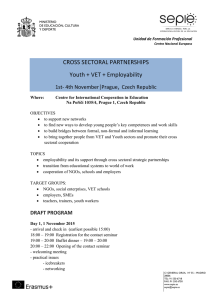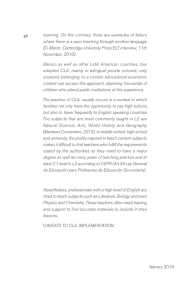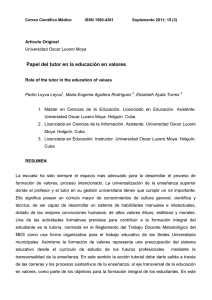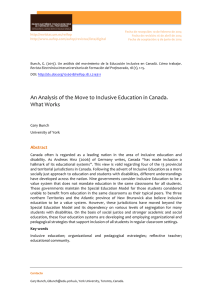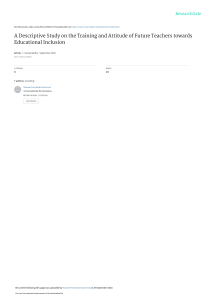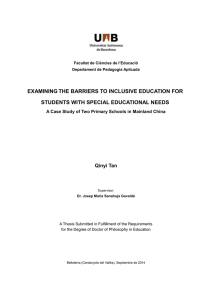full paper available for
Anuncio
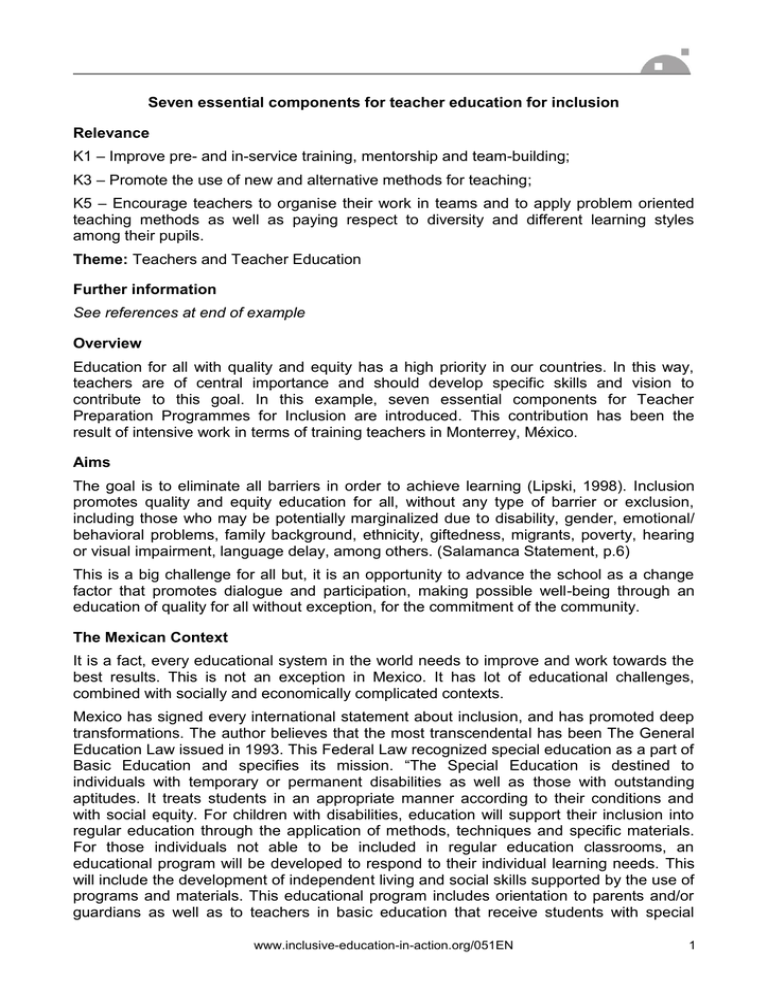
Seven essential components for teacher education for inclusion Relevance K1 – Improve pre- and in-service training, mentorship and team-building; K3 – Promote the use of new and alternative methods for teaching; K5 – Encourage teachers to organise their work in teams and to apply problem oriented teaching methods as well as paying respect to diversity and different learning styles among their pupils. Theme: Teachers and Teacher Education Further information See references at end of example Overview Education for all with quality and equity has a high priority in our countries. In this way, teachers are of central importance and should develop specific skills and vision to contribute to this goal. In this example, seven essential components for Teacher Preparation Programmes for Inclusion are introduced. This contribution has been the result of intensive work in terms of training teachers in Monterrey, México. Aims The goal is to eliminate all barriers in order to achieve learning (Lipski, 1998). Inclusion promotes quality and equity education for all, without any type of barrier or exclusion, including those who may be potentially marginalized due to disability, gender, emotional/ behavioral problems, family background, ethnicity, giftedness, migrants, poverty, hearing or visual impairment, language delay, among others. (Salamanca Statement, p.6) This is a big challenge for all but, it is an opportunity to advance the school as a change factor that promotes dialogue and participation, making possible well-being through an education of quality for all without exception, for the commitment of the community. The Mexican Context It is a fact, every educational system in the world needs to improve and work towards the best results. This is not an exception in Mexico. It has lot of educational challenges, combined with socially and economically complicated contexts. Mexico has signed every international statement about inclusion, and has promoted deep transformations. The author believes that the most transcendental has been The General Education Law issued in 1993. This Federal Law recognized special education as a part of Basic Education and specifies its mission. “The Special Education is destined to individuals with temporary or permanent disabilities as well as those with outstanding aptitudes. It treats students in an appropriate manner according to their conditions and with social equity. For children with disabilities, education will support their inclusion into regular education through the application of methods, techniques and specific materials. For those individuals not able to be included in regular education classrooms, an educational program will be developed to respond to their individual learning needs. This will include the development of independent living and social skills supported by the use of programs and materials. This educational program includes orientation to parents and/or guardians as well as to teachers in basic education that receive students with special www.inclusive-education-in-action.org/051EN 1 educational needs” (Article 41). In consequence every special education service was transformed mainly into two services; The Services Support Unit for Regular Education (USAER), a group of diverse professionals in regular schools, and the Multiple Attention Centers (CAM), attending children with profound needs, promoting independent life, and occupational inclusion, but both start from the General Curricula as a core. Another important feature of the Mexican context is the fact that every educational Programme is the responsibility, by mandate, of the Federal Department of Public Education (SEP), including all Teacher Training. In this way the Schools for Teachers (Escuelas Normales) that are public institutions of higher education and also the private schools for teachers must implement the Federal Programmes for Teachers. The SEP has made important efforts in terms of changes in all teachers’ education programmes, promoting common and general assignments for all, and also including some subjects for familiarization to inclusion, e. g Special Needs Education or Adolescents at risk. Issues and challenges Reflections on teacher education for inclusion Inclusion requires a large vision and specific competencies for all teachers. Now the teachers need to know that diversity is present in the classroom, and that they should attend to learners with a range of diverse needs. In this frame, it is imperative to prepare teachers for inclusion in all curricular plans for pre-service teachers, also for teachers in services, with the following professional aptitudes: Researcher. Always searches for explanations about their educative reality, has intellectual skills to propose diverse hypothesis, solve problems, generate innovation, and face challenges in the education field. Strategic. Is a professional with strong self- regulation, skills for planning, guiding and assessing, not only their own intellectual resources about the learning of curricular issues but also in their performance as a teacher. Always has an attitude to learn and improve. Faces uncertainty with creativity. Resilient. Always moves towards the future, in spite of their difficult situations, by making healthy adjustments against adversity. The knowledge, skills and attitudes for all inclusion teachers must emphasize that the purpose of all teacher interventions is the students’ learning. They also need to have high expectations for all (inclusive vision), develop inclusive projects including diverse teaching strategies and support systems (inclusive practices) and participate in a collective work (inclusive language). www.inclusive-education-in-action.org/051EN 2 The author identifies three important educational aspects that every teacher needs to be inclusive: Equality; promoting the same opportunities for all, quality; offering functional and meaningful learning and equity; responding to special educational needs. The implementation process Teachers are the key to success in inclusion. Here, seven essential components for Teacher Preparation Programmes are introduced based on the experience of training teachers in Monterrey Mexico. 1st. The Inclusive Teacher is a professional in education with a strong commitment to his/her community. The Teacher Preparation Programme should include subjects with high social and community content because they need to be sensitive to the needs of students and the environment; It is important to recognize the school as a point of encounter among different people, it promotes agreements among all the members of the community and meaningful relationships among the components that impact the learning of the students by removing barriers, promoting high expectations and a positive environment characterized by continuous improvement and values. The dialogue, participation and collaboration allows full awareness to all as a community and, in consequence ensures successful experiences in inclusion. For this reason the teachers need to be involved. 2nd. The Inclusive Teacher recognizes individual differences and implements learning strategies for all. The educational intervention is oriented to diversity and promotes learning strategies for all (equality), for quite a few and for only one (equity). These are other essential aspects in the teacher Preparation Programmes. Quality, equality and equity concepts should be translated into specific actions of educative interventions. In order to illustrate the individual differences in the classroom, the author follows a tridimensional view and uses an equilateral triangle to explain this approach. All three sides are equal in length, and then in the triangle’s center, “I am” is written. on the base it says: “I am like everyone” (Equality), on other side it says: “I am like someone else” and other one I write “I am the only one” (Equity). Every inclusive teacher needs to move among these three realities in his/her classroom. It also allows co-teaching or concurrent participation. Inclusion promotes co-operation in the classroom. I believe this representation helps us to understand the diversity concept as well. www.inclusive-education-in-action.org/051EN 3 In inclusive education, the school and classrooms are very dynamic and have a lot of interactions and roles. The exchange and experience enrich individuality. Diverse contexts indicate diverse relationship and interactions. The next diagram has been the result of reflections crossing views from Philosophy and Psychology. 3rd. The collaborative work among educators, facilitates inclusion and needs to be promoted in the Teacher Preparation Programme. The author believes that inclusion is funded on a collective of teachers, a team sharing knowledge, making decisions, solving problems together and generating actions in order to improve the school and to increase the learning for all. In consequence, the collaborative work is a source of dialogue, coteaching and updating. Information on the process of collaborative work now follows. La Escuela Normal de Especialización de Monterrey, institution of higher education that trains teachers in special education, promotes collaborative work in all faculties. Nowadays learning this way is invaluable and considered as a fundamental component on inclusive education. All pre-service teachers should know and develop skills in this way because: The teacher learns when teaching and the students teach when they learn. Everyone assumes tasks of leadership because we assume as protagonists. www.inclusive-education-in-action.org/051EN 4 Outcomes increase when we make synergy and identity is strengthened when we make joint decisions, shaping teams in the resolution of problems, allowing everyone to learn or re-learn social skills. The results begin when we work together because nobody will do it for us – whatever we must to do, let’s do! The economic resources are a result of collaborative work and not a condition. Heterogeneity provides a great richness. Collaboration boosts accountability and recognition processes in all communities. The process is shaped in six important steps as follows: 1. Building a common vision. Who are we? Who do we want to be? What are our goals, expectations and interests? 2. Recognizing our reality. How are we? Why are we like this? We need to analyze our beliefs and precise data information. 3. Decision-making. What are our proposals to improve our present? We need to build and establish agreement about participation. 4. Developing proposals. What are we doing to change the situation? Who? Everyone needs to know all the actions. 5. Evaluating our actions. How and how much have we advanced? Are our agreements functioning? What needs to be modified, strengthened or implemented? We need to make necessary adjustments. 6. Beginning anew. Which areas do we need to improve? What do we do? New actions for improvement. 4th. All programmes for pre-service teachers and in-service teachers must be based on the interpretative and critical paradigms. Allow encounter with others, and the collective and interpretive insight into environments and circumstances and the development of research activities are fundamental. The inclusive teacher has strong skills in action research methods. The author believes that this paradigm generates conditions for dialogue and collaboration. The dialogue needed for relationships and the essence of collaboration is the recognition of otherness. Recognizing that the other, is not a continuation of me, but has its own worldview leads teachers to explain, interpret and act from their personal background. Collaboration takes the value of the other as implicit – this implies strengths, occupations and concerns. This vision then transforms from two ideas (you and me) to a new figure (us). Such dialogue and collaboration are key elements in inclusive education. www.inclusive-education-in-action.org/051EN 5 5th. Contextual Preparation. Connecting with the educational services, allowing identification of diversity as an enriching element has three great steps outlined below. For teachers to promote inclusive education, their training should link directly with the educational services in so called contextual professional practice. This approach, in our experience, must be presented to all throughout the training process structuring with multidirectional flow between theoretical and experiences close to educational field. Three important steps are proposed: a) Re-significance of own school experience of future teachers. This period of time is essential. Each future teacher should discuss his/her own experience as a student, analyze emotions and be aware of school and pedagogical theory made by teachers, allowing them to “see” those components that were previously “hidden” such as school’s culture, school’s type, teachers, uses and customs that marked the dynamic school and the values that predominated, characterizing the experiences from other angles and points of view. It certainly requires time to work individually and collectively, interchange coincidences and differences of experiences. This time must be in the first and second semesters of teacher education programs. b) Approach to various contexts of school children. This consists of visiting previously selected schools, taking part in observation activities and educational practices in three stages: Planning activities: after assessing the educational context, it is important to develop instruments of work; observation guides, questionnaires, interviews and to make teams to provide all aspects for implementing the planned approaches. Critical route implementation. Presentation of experiences: This is done in the classroom where all of the evidence and results are presented from the previous phase. As a result of these activities, each student keeps a portfolio and checks research to support their actions. At all times they are accompanied by an experienced teacher. Certainly, they should include diverse environments, contexts, and educational services that characterize the educational system. www.inclusive-education-in-action.org/051EN 6 c) Professional practices in real environments. In the teacher’s training, the student must remain for a long period of time, in a school under the tutelage of a teacher. This teacher must exert mentoring activities, to enrich their teaching experience with the knowledge of a mentor who attends and promotes inclusion activities. At this time, the Faculty holds an agreement with diverse educational centers. Partnerships with the training institutions for teachers and schools are necessary. This enriching experience also enables the development of educational research in the corresponding professional options. The last two semesters are ideal for this important step. 6th. Cross Categorical/Multi-tiered formation. Diversity needs a global and common vision; philosophy, values, legal frame, language and shared knowledge as learning theories, special educational needs, support systems, educational intervention; strategies for large and small groups and individuality, tutoring and curricular adjustments. Inclusive education must characterize all training teacher programs, offering skills and common benchmarks for everyone regardless of education level to be entered (e.g. Primary, Secondary and High Education). This versatile training enables various teachers, regardless of their field or level of training, to collaborate and participate in the diversity of educational contexts together. The common reference on inclusive education frameworks that must be present in all Teacher Training Programs are: a) Common vision. The philosophy of inclusion, legal frameworks that enable an education for all with quality and equity, educational policy that promotes attention to diversity, the historical evolution from marginalization to inclusion and conceptions among others, are fundamental aspects in educational programs. b) Language and common knowledge. Emphasize the student’s possibilities and support systems, with a clear vision that all children can learn. In this way the school needs to prevent the barriers and limitations for learning that could marginalize children and young people from their potential. It also includes learning conception, individual differences, the values of solidarity, respect, and collaboration. Cognitive www.inclusive-education-in-action.org/051EN 7 and affective elements framed in the conception of collectivity and community empowerment as well. c) Educational attention to diversity practices. Includes strategies for large or small groups and one-on-one, mentoring, curricular adjustments, alternative support systems, diversity assessment actions, collaboration with other professionals and coteaching, trans-disciplinary action, among others. They are essential for the development of the professional skills of attention to diversity. 7th. Mentoring. New teachers must participate with experienced teachers at least during the first two years. This includes dialogue sessions, reviews of situations, decision-making arrangements and work plans, among others to provide the following to the new teacher: intervention (guidance), facilitation (advice), and cooperation (co-responsibility). The new teacher needs counseling and mentoring actions to consolidate his/her skills as an inclusive teacher. Whereas educational dynamic is intense and complex, it is necessary that new teachers participate under the accompaniment and mentoring of experienced teachers to enable consolidation of an inclusive vision in those teachers. It seems that this is essential to ensure the best results in the first years of teaching work. Many education systems face the phenomenon of “burnout” among their teachers, often causing the abandonment of the teaching task, or loss of enthusiasm and commitment. This is a terrible loss to any education system or country. Mentoring are actions carried out by a teacher, preferably of the same school, or networks of teachers that assume this important task. It requires a lot of creativity and a clear and definite plan for the monitoring of such actions. The time should be defined by each environment, however this task should be carried out at least in the first year very closely and the second year in a more distant way. Nieto (2004) identifies three models of advice that characterize actions of accompaniment and mentoring: a) Intervention. The role of the experienced teacher is directive and assumes a leadership position, where instruction is given through interpersonal behavior which provides materials and ideas to be adapted, and so dominates the transmission of www.inclusive-education-in-action.org/051EN 8 information with an emphasis on the explanation and application of knowledge and skills. b) Facilitation. The role of the experienced teacher is consulting. His/her interaction with the novice teacher provides advice and listens, encourages and clarifies. The experienced teacher provides materials designed for this purpose and promotes the discussion and review of diverse conceptions. The experienced teacher assumes a role of coordinator of decisions and is a strong observer. This model focuses on interactive work methodology and improves the quality of action processes. c) Cooperation. A critical friend or colleague is the experienced teacher role and their relationship is interdependent and a source of mutual learning, shared responsibility, experience or convergence of perspectives. Materials and ideas are developed together. There is an awareness of reaching agreements and reaching a consensus on courses of action. Cooperative research is promoted. Both input to the improvement plan. There is shared leadership and promotion of interdependence, reciprocity, collegiality and solidarity. The best features of accompaniment and mentoring are developed under the facilitation and cooperation approach. Key outcomes and lessons learned The inclusive teacher should be accompanied in his early professional development by a mentor, following the facilitation and cooperation models. The profile for the inclusive teacher should be as follows: The inclusive teacher is a professional educator committed to his/her community, that recognizes individual differences and considers them in his/her educational intervention actions. S/he participates in collective teaching because it is essential for collaboration and dialogue and is also creative in implementing education by facing the challenges of diversity in specific educational project interventions. The inclusive teacher by their multi-tiered formation has a holistic educational view with strong skills and experience in order to participate in diverse contexts. In our teacher programs, we are promoting each one of the seven essential components; combining the federal program (by mandate) with our complementary program. The focus of all the actions is to develop an approach to inclusive education teacher. Some conclusions are: www.inclusive-education-in-action.org/051EN 9 a) Work together with other institutions to build a collaborative network, connecting colleagues and diverse professionals, interchanging knowledge and making new friends. b) Promote educational research projects to develop innovation. c) Participate in diverse social and educative programs in each community. d) Support the collaborative work of all teachers because it is the best way to attend to the diversity of our schools. In this sense, the mentoring process has a transcendent role. e) Choose the best student profile for teacher education. f) Enrich the Teacher Preparation Programs, with transversal competencies along the curricular plan. g) Increase all professional skills in term of alternative and augmentative communication systems such as Braille, Sign Language and Communication Board through a supplementary program. h) Make educational proposals to the Federal Education Department in order to improve the Training Teachers in Mexico based on action research. i) Collaborate with academic centers to share knowledge. Inclusion has been incorporated into almost every educational system, but we still need to learn and understand the real meaning of Education for All with quality and equity and recognize the fundamental role of teachers in the advancement of social justice, human rights, and opportunities for welfare. Each one of us needs to face the challenges in order to consolidate inclusion for the benefit of our community. Contact details Humberto Javier Rodríguez Hernández E-mail: [email protected] References Ainscow, M., 1999. Understanding the development of inclusive school. London: Falmerpress. Ainscow, M., 2004. Salamanca 10 años después: ¿qué impacto ha tenido en el ámbito internacional? (Salamanca, 10 years later. What impact has had in the international scope?) The University of Manchester. www.educacionespecial.sepdf.gob.mx/educacion inclusiva/documentos/PoliticaInternacional/DiezSalamanca.pdf Anaiz, P., 1996. Procesos de enseñanza aprendizaje ante las necesidades educativas especiales en Didáctica y organización en Educación Especial. (Teaching and learning processes front the special education needs in Didactic and Special Ed organization) Málaga. Aljibe. Avramidis, E and Norwich, B., 2002. Teachers’ attitudes towards integration/Inclusion: “A review of the literature”. European Journal of Special Needs Education. Barber, M., 2008. Cómo hicieron los sistemas educativos con mejor desempeño del mundo para alcanzar sus objetivos. (How made the educational systems with better perform of the world for to reach their objectives?) deL.No.41 Santiago. ISSN 0718-6002. www.preal.org/publicacion.asp Blanco, R., 2005. Protagonismo docente en el cambio educativo. (Educational Leadership in the educative change) Proyecto Regional de Educación para América Latina y el Caribe. Santiago. UNESCO. Booth, T.,Nes,K. and Stromstd,M., 2003. Developing Inclusive teacher Education, London: RoutledgeFalmer. www.inclusive-education-in-action.org/051EN 10 Burbules, N., 1997. A grammar of difference: some ways of rethinking difference and diversity as educational topics. Australian Educational Researcher. Carver, C., 1998. Resilience and thriving; issues, models and Linkages. Journal of Social Issues, 54. Casanova, M y Miguel Ángel Cabra. (Coord), 2009. Educación y personas con Discapacidad: Presente y Futuro ( Education and persons with disabilities: Present and future). Madrid. ONCE. Casanova, M y Humberto Rodríguez. (Coord), 2009. La inclusión educativa, un horizonte de posibilidades. (The inclusive education, a horizon of possibilities) Madrid. Ed. La Muralla. Corbett, J., 1999. Inclusion and exclusion. En L. Barton (eds): Difference and difficulty, insights, issue and dilemmas. University of Sheffield. Council for Exceptional Children, 2009. What Every Special Educator Must Know. Ethics, Standards and Guidelines. Arlington. CEC. Darling-Hammond, L, 2001. El derecho de aprender. Crear buenas escuelas para todos. (The right to learn. A blueprint for for creating Schools that work) Barcelona: Ariel. Darling-Hammond, L., 2003. El desarrollo profesional de los maestros. Nuevas estrategias y políticas de apoyo. (The Profesional Development of teachers. New strategies and support politics.) México. SEP. Delors J, (comp), 1996. Los cuatro pilares de la educación en la Educación encierra un tesoro. (The four pillars of education in Learning: The Treasure Within) UNESCO. www.unesco.org/education/pdf/DELORS_S.PDF Domingo, J., 2004. Asesoramiento al centro educativo (Advice to educational center) México: SEP. Biblioteca para la actualización del maestro. Echeita, G y M, Verdugo, 2004. La Declaración de Salamanca sobre necesidades Educativas Especiales. 10 años después. Valoración y prospectiva. (The Salamanca Statement on special education needs. 10 years later. Appreciation and prospective) Salamanca.ISBN84-688-9397-8 www.eenet.org.uk/other_langs/declaracion_salamanca_completo.pdf European Agency for Development Special Needs Education, 2003. Educación inclusiva y prácticas en el aula (The inclusive education and practices in the classroom) ISBN-8791350-21-2 www.european-agency.org/publications Ferrer, G., 2006. Los estándares en educación. Implicaciones para su aplicación en América Latina (The standards in education.Implications for their application in Latin America. PREAL. Forlin, Ch., 2008. Reform, inclusion and Teacher Education.Towards a new era of special education in the Asia-Pacific region.New York. Routledge. Fundación Europea Sociedad y Educación, 2007. libertad, calidad y equidad en los sistemas educativos. (Freedom, quality and equity in the educational systems) Madrid. Europe comission centre for reserch on lifelong learning. Ferguson, D., 2008. International trends in inclusive education: the continuing challenge to teach each one and everyone. European Journal of Special Education Needs, 23. Giné, C., 2004. La declaración de Salamanca . Valoración y prospectiva desde Cataluña (The Salamanca Statement. Assessment and prospective since Cataluña) en La Declaración de Salamanca sobre necesidades Educativas Especiales. 10 años después. Valoración y prospectiva. Garagorri, X., 2007. Currículo basado en competencias: aproximación al estado de la cuestión ( Curriculum based on competencies: approach to cuestion frame) en Aula de innovación Educativa, Núm. 161. www.inclusive-education-in-action.org/051EN 11 Giroux, H. A., 1990. Los profesores como intelectuales. Hacia una pedagogías crítica del aprendizaje. (the teachers as a intelectuals. Toward a interpretative pedagogic of learning) Barcelona: Paidós. Heward, W., 2009. Exceptional children. An introduction to Special Education. New Jersey:Pearson. Imbernón, F., 2002. La formación y el desarrollo profesional del profesorado. (The training and profesional development of teachers) España, Graó. Imbernón, F et al., 2007. La investigación educativa como herramienta de formación del profesorado. (The educational research as a training teachers tools) Barcelona: Graó. Informe TALIS, 2009. La creación de entornos eficaces de enseñanza y aprendizaje.(Creating Effective Teaching and Learning Enviroments) TALIS Report. OCDE. Santillana. Jiménez M, y Montserrat Vila sun, 1999.: De Educación Especial a Educación en la Diversidad (From special education to education in the diversity). Málaga: Aljibe. Lipsky D.K. Y Garther, A., 1998. Factors for successful inclusion: learning from the past, looking toward the future. En S.J. Vitello y D. E. Mithaug (Eds.).Inclusive schooling.National and internationalperspectives. New Jersey: Lawrence ErlbaumAssociates. López, M., 2004. Construyendo una Escuela sin Exclusiones (Building a School without exceptions), Málaga: Aljibe. Marcelo, C., 1994. Formación del profesorado para el cambio educativo( Training teachers for the educational change). Barcelona: Promociones y Publicaciones Universitarias. Martínez, M. y Buxarrais, M. R., 1998. La necesidad de educar en valores en la escuela (The need of educate in values in the School). Aula de Innovación Educativa. ISSN 1131995X No. 70 Monereo, C., 1998. Estrategias de enseñanza y aprendizaje. Formación del profesorado y aplicación en el aula (Strategies for teaching and learning. Training teachers and enforcement in the classroom). Biblioteca del Normalista, SEP, México. Moriña, A., 2004. Teoría y Práctica de la Educación Inclusiva (Theory and praxis in inclusive education) ed. Málaga: Aljibe. Ministerio de Educación, Chile, 2001. Estándares de desempeño, para la formación inicial de docentes.(Performances’ standards for the training teachers) Nieto, J. Modelos de asesoramiento (Advice’s models) en Asesoramiento al centro educativo en Jesús Domingo Segovia, (2004) SEP. México. Kozlesky, E., 2005. On…Transformed, Inclusive Schools. A framework to guide fundamental change in urban schools www.urbanschools.org/pdf/transformedSchools.pdf Ogot, O., 2004. Desarrollando ambientes inclusivos. (Developing inclusive environments) En Edición Especial: Salamanca-diez años después. UNESCO 2004. Perrenoud, P., 2004. Diez nuevas competencias para enseñar (Ten news skills for teaching). México. SEP. Perrenoud, P., 2007. Desarrollar la práctica reflexiva en el oficio de enseñar (To Develop the reflective praxis in the teaching skill,) México: Colofón. Ravitch, D., 2010. The Death and Life of the Great American School System: How testing and Choice are Undermining Education. New York: Basic Books. Robalino, M., 2005. Protagonismo docente en el cambio educativo (Educational Leadship in the educational change). Santiago. UNESCO. Revista Prelac. No. 1 Rodríguez, S., 2003. Nuevos retos y enfoques de la formación del profesorado universitario (News Challenges and approaches on the training academic professors). Revista de Educación 331. INCE. www.inclusive-education-in-action.org/051EN 12 Rodríguez, H., 2007. Inclusive Model in Training Special Education Teachers: An experience in Monterrey, México. Documento presentado en la Convención del CECDISES. Louisville. Kentucky. (paper) Rodríguez, H y Rebeca Rodríguez, 2008. Hacia un modelo preliminar del Trabajo de Tutoría. (Toward a preliminar model of Tutor Work) Research report. Informe de investigación. Monterrey. Rodríguez, H, 2009. paper.La inclusión educativa. Reflexiones y algunos retos que nos urge afrontar. (The inclusive education. Reflections and some challenges that we need to face) Román, M y Eloísa Díez, 2008. Diseños curriculares de Aula en el marco de la sociedad del conocimiento (curricular design for classroom in the knowledge society frame). Madrid. EOS. Ruiz, M., 2007. La formación en competencias. Tres procesos metodológicos esenciales (The training in competencies. Three essential methodology processes). Monterrey. UANL. Saleh, L., 2004. Desde Torremolinos a Salamanca y más allá. Un tributo a España. (Since Torremolinos to Salamanca and beyond. A tribute to Spain) En la Declaración de Salamanca sobre Necesidades Educativas Especiales 10 años después. Valoración y Prospectiva de Echeita G y Miguel Ángel Verdugo. Schmelkes, S., 2000. Hacia una mejor calidad de nuestras escuelas (Toward the better quality in our Schools). México. SEP. Sandkull, O., 2004. promoviendo ambientes inclusivos, amigables para los alumnos y alumnas de la región Asia-Pacifico. (Promoting inclusive environment for students in the Asia-Pacific Region) En UNESCO. Edición Especial: Salamanca-Diez años después. Savater, F., 2003. Los caminos para la libertad. Ética y Educación. (The freedom ways: Ethic and Education) México: Fondo de Cultura Económica. Smith, T., 2001. Teaching Students with Special Needs in Inclusive Settings. USA: Pearson. Stainback, S. Stainback W., 1999. Aulas Inclusivas. (Inclusive Classroom) Madrid. Narcea. Tobón, S., 2006. Aspectos básicos de la formación basada en competencias (Basic aspects in the training supported in competencies). Bogotá: ECOE Tobón, S at al., 2006. Competencias, calidad y educación superior.(Competencies, quality and Higher Education) Bogotá: ECOE. 1995c: Las necesidades educativas especiales. Conjunto de materiales para la formación de profesores. París: UNESCO. UNESCO, 2002. Information and communication Technologies in Teacher Education,a Planning Guide. Paris: UNESCO. UNESCO, 2004. Salamanca-Diez años después. Edición Especial. (Salamanca, Ten Years Later .Enabling Education Number 8 . www.eenet.org.uk UNESCO, 2005. Protagonismo Docente en el cambio educativo. (Educational Leadership in the Educational Change) Santiago. Revista PRELAC No.1 UNESCO, 2005. Hacia las sociedades del conocimiento. (Toward the Knowledge sociaties) ISBN 92-3-304000-3. UNESCO, 2008. Los aprendizajes de los estudiantes de América Latina y el Caribe. Primer Reporte de los Resultados del Segundo Estudio Regional Comparativo y Explicativo. (The Students Learning in Latin America and Caribbean. Second Comparative and Explicative Report) Santiago. ISBN: 978-956-8302-93-1 Winzer, M., & Marurek, K., 2009. Inclusive schooling; Global ideas and national realities. Journal of International Special Needs Education, 12, 1-10. Zabala, A y Laia Arnau, 2007. La enseñanza de las competencias en 11 ideas clave. (TheTeaching of Competencies in 11 key ideas) Barcelona. Graó. www.inclusive-education-in-action.org/051EN 13 www.urbanschools.org/publications/pub.español.html On transformed Inclusive Schools and Improving education: The promise of Inclusive Schooling. NIUSI.NationalInstituteforUrbanSchoolImprovement. www.jccm.es/edu/cpr/alcazar/downloads/Escin.pdf (2007) La escuela inclusiva. Su concreción en Castilla-La Mancha. (The Inclusive School. Their concretion in Castilla-La Mancha). www.unesco.org/education/pdf/SALAMA_s.pdf Salamanca Statement. www.inclusive-education-in-action.org/051EN 14

